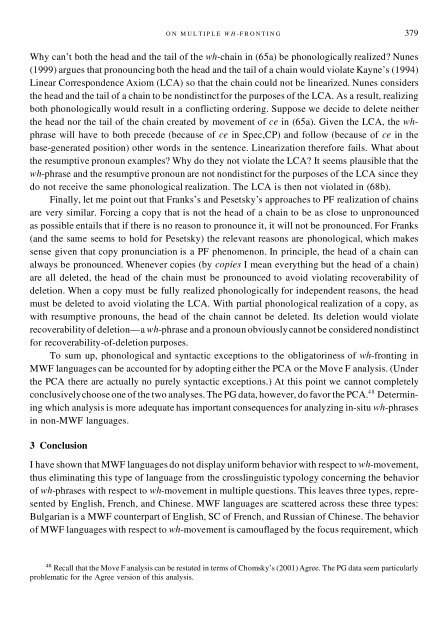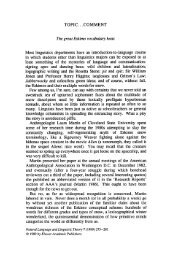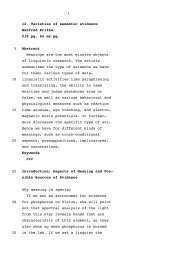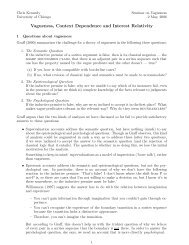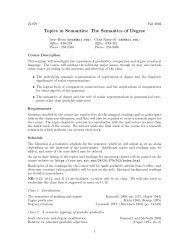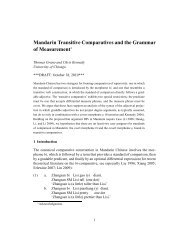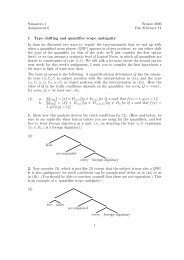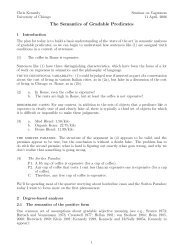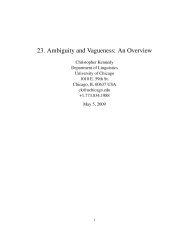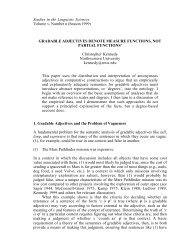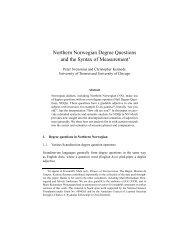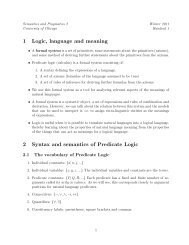On Multiple Wh-Fronting - University of Chicago
On Multiple Wh-Fronting - University of Chicago
On Multiple Wh-Fronting - University of Chicago
You also want an ePaper? Increase the reach of your titles
YUMPU automatically turns print PDFs into web optimized ePapers that Google loves.
O N M U L T I P L E W H - F R O N T I N G 379<strong>Wh</strong>y can’t both the head and the tail <strong>of</strong> the wh-chain in (65a) be phonologically realized? Nunes(1999) argues that pronouncing both the head and the tail <strong>of</strong> a chain would violate Kayne’s (1994)Linear Correspondence Axiom (LCA) so that the chain could not be linearized. Nunes considersthe head and the tail <strong>of</strong> a chain to be nondistinctfor the purposes <strong>of</strong> the LCA. As a result, realizingboth phonologically would result in a conflicting ordering. Suppose we decide to delete neitherthe head nor the tail <strong>of</strong> the chain created by movement <strong>of</strong> ce in (65a). Given the LCA, the whphrasewill have to both precede (because <strong>of</strong> ce in Spec,CP) and follow (because <strong>of</strong> ce in thebase-generated position) other words in the sentence. Linearization therefore fails. <strong>Wh</strong>at aboutthe resumptive pronoun examples? <strong>Wh</strong>y do they not violate the LCA? It seems plausible that thewh-phrase and the resumptive pronoun are not nondistinct for the purposes <strong>of</strong> the LCA since theydo not receive the same phonological realization. The LCA is then not violated in (68b).Finally, let me point out that Franks’s and Pesetsky’s approaches to PF realization <strong>of</strong> chainsare very similar. Forcing a copy that is not the head <strong>of</strong> a chain to be as close to unpronouncedas possible entails that if there is no reason to pronounce it, it will not be pronounced. For Franks(and the same seems to hold for Pesetsky) the relevant reasons are phonological, which makessense given that copy pronunciation is a PF phenomenon. In principle, the head <strong>of</strong> a chain canalways be pronounced. <strong>Wh</strong>enever copies (by copies I mean everything but the head <strong>of</strong> a chain)are all deleted, the head <strong>of</strong> the chain must be pronounced to avoid violating recoverability <strong>of</strong>deletion. <strong>Wh</strong>en a copy must be fully realized phonologically for independent reasons, the headmust be deleted to avoid violating the LCA. With partial phonological realization <strong>of</strong> a copy, aswith resumptive pronouns, the head <strong>of</strong> the chain cannot be deleted. Its deletion would violaterecoverability <strong>of</strong> deletion—a wh-phrase and a pronoun obviously cannot be considered nondistinctfor recoverability-<strong>of</strong>-deletion purposes.To sum up, phonological and syntactic exceptions to the obligatoriness <strong>of</strong> wh-fronting inMWF languages can be accounted for by adopting either the PCA or the Move F analysis. (Underthe PCA there are actually no purely syntactic exceptions.) At this point we cannot completelyconclusivelychoose one <strong>of</strong> the two analyses. The PG data, however, do favor the PCA. 4 8 Determiningwhich analysis is more adequate has important consequences for analyzing in-situ wh-phrasesin non-MWF languages.3 ConclusionI have shown that MWF languages do not display uniform behavior with respect to wh-movement,thus eliminating this type <strong>of</strong> language from the crosslinguistic typology concerning the behavior<strong>of</strong> wh-phrases with respect to wh-movement in multiple questions. This leaves three types, representedby English, French, and Chinese. MWF languages are scattered across these three types:Bulgarian is a MWF counterpart <strong>of</strong> English, SC <strong>of</strong> French, and Russian <strong>of</strong> Chinese. The behavior<strong>of</strong> MWF languages with respect to wh-movement is camouflaged by the focus requirement, which48 Recall that the Move F analysis can be restated in terms <strong>of</strong> Chomsky’s (2001) Agree. The PG data seem particularlyproblematic for the Agree version <strong>of</strong> this analysis.


